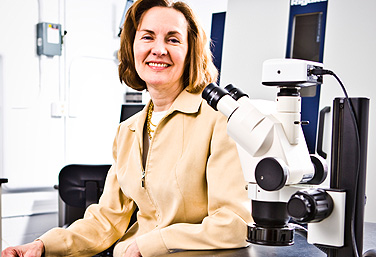News
Takeuchi to be inducted into
National Inventors Hall of Fame

Esther Takeuchi has earned more patents than any other woman in the U.S.—148 at last count and growing—most of them related to her pioneering development of sophisticated power sources for implantable devices. Photo: DOUGLAS LEVERE
-
 Print
Print -
 Comments
Comments
-
“I have this belief that what we are doing in the lab should have a direct impact on human lives.”
Esther Takeuchi, SUNY Distinguished Professor and Greatbatch Professor of Advanced Power Sources at UB, will be one of nine living inductees into the National Inventors Hall of Fame, according to an announcement today by the NIHF, which honors legendary inventors whose innovations have changed the world.
Takeuchi has earned more patents than any other woman in the U.S.—148 at last count and growing—most of them related to her pioneering development of sophisticated power sources for implantable devices, now a booming multibillion-dollar business.
“Professor Takeuchi’s ingenuity and pursuit of what is truly innovative has made possible devices that are saving millions of lives,” says Harvey G. Stenger, dean of the UB School of Engineering and Applied Sciences. “As a visionary scientist and innovator at UB, and now as an inductee into the National Inventors Hall of Fame, she is taking her rightful place alongside the most famous inventors of our time.”
Takeuchi developed the battery that enabled implantable cardiac defibrillators (ICDs), a feat that brought her to the White House in fall 2009 where President Obama presented her with the National Medal of Technology and Innovation. ICDs are the leading therapy for treating serious cardiac arrhythmia, with more than 300,000 lifesaving devices implanted per year. There was no prior battery technology that could provide the essential energy needed to bring ICDs from concept to reality.
A UB faculty member since 2007, Takeuchi has been conducting research targeted at creating special energy storage solutions for special circumstances.
“This is an exciting time to be working in energy,” says Takeuchi. “On the human level, there is a multitude of currently intractable medical conditions that could be addressed by electrotherapy, ranging from cardiac-rhythm issues to neurological disorders to paralysis to epilepsy to chronic pain. On the societal level, batteries could revolutionize transportation and grid-level energy storage, liberating us from dependence on fossil fuels and bringing us closer to a sustainable energy future. All of this is possible with new approaches to harness the delicate and microscopic interactions of molecules with electrons.”
During her tenure at UB, she has been an inventor on two patents to date.
“Patents are one of the things that drive me,” says Takeuchi. “I have this belief that what we are doing in the lab should have a direct impact on human lives. Fundamental research is the basis, but for me, thinking about that next step is also important.”
Universities are beginning to understand that patents are as important to academic success as the more traditional measures, such as peer-reviewed publications and external funding, Takeuchi says. She notes that inventions that occur at a university can provide the core ideas to launch new companies if the initial funding is available, companies that can play a significant role in driving the future U.S. economy.
But the pipeline of innovation that patents represent could be threatened, Takeuchi says, by the continued lack of diversity in science and engineering.
“Individuals with different backgrounds and distinct perspectives are the core of innovation,” she says. “What is considered creativity on the part of an individual may, in fact, be a different perspective. By not involving huge segments of society, such as women, we lose out on potential progress.”
Takeuchi notes that her own success has been sustained in no small part by the enthusiasm and support of her husband, Kenneth Takeuchi, SUNY Distinguished Teaching Professor in the UB Department of Chemistry, with whom she now collaborates.
“Women often receive pressure to separate work life and home life,” she says. “However, any creative or leadership endeavor requires thought, concentration and effort. Husbands can encourage their wives by not just tolerating when they contemplate work at home, but by celebrating it.”
Takeuchi holds faculty positions in the departments of Chemical and Biological Engineering, Electrical Engineering and Chemistry, as well as in the recently formed Department of Biomedical Engineering. She is a member of the faculty advisory board of the strategic strength Integrated Nanostructured Systems identified in the UB 2020 planning process, which brings together researchers in the life sciences, medicine and engineering to promote interdisciplinary advancements.
Takeuchi recently was named a member of the National Science Foundation’s Mathematical and Physical Sciences Advisory Committee, a post she will hold until 2013. The committee’s deliberations and recommendations are a core part of the NSF’s strategic planning and policy formulation process.
Named to the prestigious National Academy of Engineering in 2004, Takeuchi is one of just 113 women elected to the organization, considered the highest distinction that an engineering professional can achieve. Less than 5 percent of the academy's 2,492 active members are women.
A fellow of the American Institute for Medical and Biological Engineering, Takeuchi received the 2008 Astellas USA Foundation Award, administered by the American Chemical Society.
She earned her doctorate in chemistry at The Ohio State University and completed postdoctoral work in electrochemistry at the University of North Carolina and UB. She received a bachelor’s degree from the University of Pennsylvania with a double major in chemistry and history.

Reader Comments